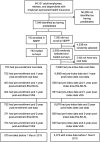Cost-effectiveness of the National Diabetes Prevention Program: A Real-world, 2-Year Prospective Study
- PMID: 39565893
- PMCID: PMC12178621
- DOI: 10.2337/dc24-1110
Cost-effectiveness of the National Diabetes Prevention Program: A Real-world, 2-Year Prospective Study
Abstract
Objective: We evaluated the real-world cost-effectiveness of the National Diabetes Prevention Program (NDPP) for people with prediabetes in a large workforce with employer-sponsored health insurance.
Research design and methods: We performed difference-in-differences analyses using individual-level health insurance claims and survey data for 5,948 adults with prediabetes who enrolled (n = 575) or did not enroll (n = 5,373) in the NDPP to assess NDPP's effects on health economic outcomes. We assessed direct medical costs for the year before the NDPP enrollment/index date and for 2 years thereafter; EuroQol 5-dimension 5-level questionnaire (EQ-5D-5L) utility scores at baseline, 1 year, and 2 years; and quality-adjusted life-years (QALYs) over 2 years. We used propensity score weighting to adjust for potential bias due to self-selection for enrollment, multiple imputation to handle missing data, and bootstrapping to produce CIs. We adopted a health care sector perspective and discounted costs and QALYs at 3% annually. Costs were expressed in 2020 U.S. dollars.
Results: Compared with nonenrollees, each NDPP enrollee had an average reduction of $4,552 (95% CI -13,231, 2,014) in 2-year total direct medical costs. Cost savings were primarily related to hospitalizations, outpatient visits, and emergency room visits. Compared with nonenrollees, each enrollee had no difference in EQ-5D-5L utility scores at 2 years or QALYs gained over 2 years. The uncertainty analyses found that enrollment in the NDPP had an 88% probability of saving money and 84% probability of being cost-effective at a willingness-to-pay threshold of $100,000 per QALY gained over 2 years.
Conclusions: In this real-world population with prediabetes, enrollment in the NDPP was likely to provide cost savings.
© 2024 by the American Diabetes Association.
Conflict of interest statement
Figures



Comment in
-
The U.S. National Diabetes Prevention Program (NDPP) Shows Promise as a Cost-effective Implementation Strategy.Diabetes Care. 2025 Jul 1;48(7):1150-1151. doi: 10.2337/dci24-0100. Diabetes Care. 2025. PMID: 40540680 No abstract available.
Similar articles
-
The effectiveness and cost-effectiveness of carmustine implants and temozolomide for the treatment of newly diagnosed high-grade glioma: a systematic review and economic evaluation.Health Technol Assess. 2007 Nov;11(45):iii-iv, ix-221. doi: 10.3310/hta11450. Health Technol Assess. 2007. PMID: 17999840
-
The clinical effectiveness and cost-effectiveness of cardiac resynchronisation (biventricular pacing) for heart failure: systematic review and economic model.Health Technol Assess. 2007 Nov;11(47):iii-iv, ix-248. doi: 10.3310/hta11470. Health Technol Assess. 2007. PMID: 17999842
-
Noninvasive Vagus Nerve Stimulation for Cluster Headache and Migraine: A Health Technology Assessment.Ont Health Technol Assess Ser. 2025 May 1;25(2):1-177. eCollection 2025. Ont Health Technol Assess Ser. 2025. PMID: 40496978 Free PMC article.
-
Hybrid closed-loop systems for managing blood glucose levels in type 1 diabetes: a systematic review and economic modelling.Health Technol Assess. 2024 Dec;28(80):1-190. doi: 10.3310/JYPL3536. Health Technol Assess. 2024. PMID: 39673446 Free PMC article.
-
Automated devices for identifying peripheral arterial disease in people with leg ulceration: an evidence synthesis and cost-effectiveness analysis.Health Technol Assess. 2024 Aug;28(37):1-158. doi: 10.3310/TWCG3912. Health Technol Assess. 2024. PMID: 39186036 Free PMC article.
Cited by
-
Prediabetes.Nat Rev Dis Primers. 2025 Jul 17;11(1):49. doi: 10.1038/s41572-025-00635-0. Nat Rev Dis Primers. 2025. PMID: 40676018 Review.
-
Is the Current Lifestyle Modification Approach to Diabetes Prevention in the U.S. a Success?Diabetes Care. 2025 Jun 1;48(6):863-870. doi: 10.2337/dci24-0040. Diabetes Care. 2025. PMID: 40267363 Review.
-
Piezoelectric-immunomodulatory electrospun membrane for enhanced repair of refractory wounds.J Nanobiotechnology. 2025 May 6;23(1):333. doi: 10.1186/s12951-025-03393-z. J Nanobiotechnology. 2025. PMID: 40329325 Free PMC article.
References
-
- Centers for Disease Control and Prevention . National Diabetes Statistics Report. Accessed 25 April 2024. Available from https://www.cdc.gov/diabetes/data/statistics-report/index.html
-
- Parker ED, Lin J, Mahoney T, et al. Economic costs of diabetes in the U.S. in 2022. Diabetes Care 2024;47:26–43 - PubMed
MeSH terms
Grants and funding
LinkOut - more resources
Full Text Sources
Medical

